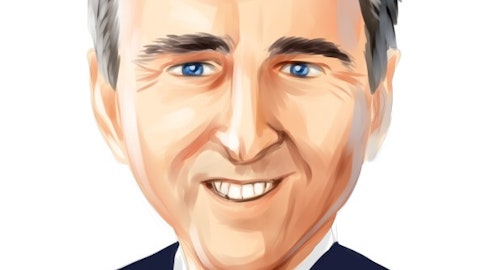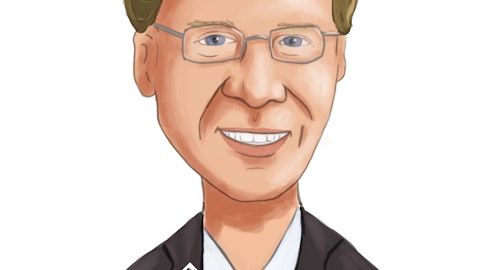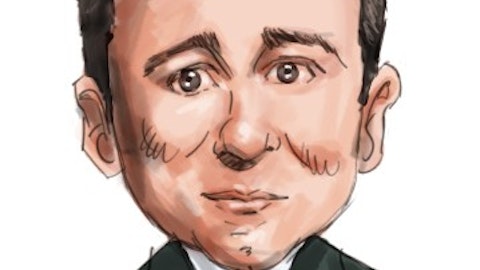Operator: And we will take our next question from Karl Shepard with RBC Capital Markets. Your line is open.
Karl Shepard: Hey, good afternoon, everyone. I appreciate all the color on deposit betas. But I guess I wanted to follow up to and ask about asset yields. Just kind of what are you thinking about asset yield lift as we roll through kind of the back half of the year assuming kind of your rate forecast?
Jim Reske: Actually, the asset deals are — we’re still asset sensitive. And so there’s still upside on the asset side. If you look at where we kind of went this quarter, it was a quarter where the Fed rate raised 50 basis points and the asset yields went up by about 50 basis points. So kind of — I’m not sure, if it works that way every quarter but that’s kind of a 100% loan beta at least for the first quarter this year. But the new loans are coming on a really nice yield. I’m sorry Mike…
Mike Price: No, no go ahead.
Jim Reske: Yeah. So we’re pleased to see where that’s happening. And so even with — for example some portfolios with minimal loan growth the replacing yields are still pretty strong. Significant portfolio doesn’t grow. The new loans that are coming on are coming out of higher rates of the loans that are coming off.
Mike Price: Yeah. And Centric added a little to our asset sensitivity probably just over two-thirds of the commercial loans were variable – that’s right.
Karl Shepard: Okay. And then kind of switching over to lending. I think Mike you mentioned taking a measured approach I think was your wording. Just curious what’s driving that? I noticed maybe lower construction commitments in the materials but just can you help me understand that? And it feels like maybe a slight tweak in the loan growth outlook, but I don’t think you guys are signaling still a kind of a weaker environment.
Mike Price: Yeah. I think the — it’s determined by price and some of the yields on some of our consumer categories had gotten a little tight. So we raised some rates and that restricted some volume particularly in the indirect business. We’re still doing a lot of indirect more — a little bit more on our terms. We have a very experienced leader there. We like the business we’re getting just not as much of it. And then I also think — some of the businesses have slowed down a bit. Mortgage has hopefully bottomed out and they’re turning the corner there. And the commercial side, the commercial real estate has backed up a little bit as well. We have nice pipelines I would say more so in C&I in our regions than we’ve had in a while. And so that’s — and also obviously our new Equipment Finance business everything that’s put on there will stick to the balance sheet since that’s relatively new.
Karl Shepard: Great. Thanks a lot.
Operator: And we will take our next question from Daniel Tamayo with Raymond James. Your line is open.
Daniel Tamayo: Hey, good afternoon, everybody. Maybe first we can start on the office commercial real estate portfolio. I appreciate the new disclosures. But if you could just talk about maybe the dispersion of that office portfolio kind of where it is within your markets if there’s any of it kind of Central Business District particularly the big metro areas that you get listed on that slide?
Mike Price: I’ll hand it off to Brian Karrip, our Chief Credit Officer in a minute. But just a $5.4 million average commitment rent per square foot in the space of about $17.65, which is really well-below East and West Coast rents and then good debt service coverage of about $1.53 and loan to value of 63.2%, which just means that vacancy could go up quite a bit and a developer — it won’t break the developer. Brian, why don’t you add a little more commentary to slide 17.
Brian Karrip: Thank you. Thanks Mike and thanks Daniel for your question. So when we think about our book and the dispersion of the portfolio, we have a subscription with a global real estate firm that provides information and analytics and we receive monthly updates. We think that our portfolio has behaved as well if not better than most others. Let’s talk about the materials we gave you. Our markets are stable and very predictable. As we break our portfolio down and think about our geographic dispersion across each of the markets identified on slide 17, we further define it as what a Central Business District and what is in the suburban. So we have about $87 million that is in Central Business District and it’s performing reasonably well.
As we think about the balance of the book and the materials we provided there were only two loans above $15 million in the portfolio. One loan is secured by multiple properties and those are leased to the federal government. And the second loan is got a tenant that’s a global credit tenant. So the office book has performed fine, notwithstanding, all the concern and the noise. We focus on this book and have focused on it since the pandemic. And it may not come out in the slides, but we’re down about $77 million over the past year or so, 14 months and we’ll continue to work to appropriately size this book given the economic conditions.
Daniel Tamayo: That’s great color. I appreciate all that. And then switching gears to my follow-up here for you Jim. The reserves are much stronger after the deal now at 1.55. Just curious on your facts if you think that still will drift up potentially from here, obviously, a lot of questions in terms of what would happen in the environment but just interested in your thoughts about the ACL here?
Jim Reske: No, I appreciate that a lot. And I’ll start and then Brian if you have some further thoughts you can add to it as well. With the acquisition and the marks, the mark contributed to the ACL and give us a little bit of a reset following the acquisition, nice higher level of 1.35 to 1.55. So if anything that compares more favorably to peers than it did before, it creates a little less pressure in that sense. After this kind of reset for the acquisition then the normal pressures just resume. Provision expense is going to be driven by loan growth and then changes in our Moody’s economic forecast. So after the reset it’s back to the same pressure as it was before and have been for a while. Brian I don’t know if there’s anything you wanted to add to that?
Brian Karrip: No that was well put.
Jim Reske: We hope that is outstanding.
Daniel Tamayo: It does. Thanks guys. Appreciate it. That’s all for me.
Jim Reske: Thank you.
Daniel Tamayo: Thanks.
Operator: And we’ll take our next question from Matthew Breese with Stephens. Your line is open.
Matthew Breese: Good afternoon.
Jim Reske: Good afternoon.
Matthew Breese: A few modeling questions on my end. Sorry, if I missed it in your opening comments, but I was curious what accretable yield was for the quarter and then the outlook for the rest of the year?
Jim Reske: It’s about 5.5 basis points in the quarter. It’s hard to give you because the CECL is going to go up and down based on how credit performs. So it’s hard to give you where that’s going to go for the rest of the year, but it’s 5.5 for the first quarter.
Matthew Breese: Okay. And then I hope…
Jim Reske: …for rest of the year and I’ll update you as we go along.
Matthew Breese: Okay. And then turning to the securities portfolio. It’s been a decline for five or six quarters now. Just wanted to get an updated message on what you’re doing with cash flows there and if there’s any appetite to add to it?
Mike Price: Jim?
Jim Reske: Yes, thanks for asking. Great question. We do — I think it will change our approach. We — as you noted we have been letting it run off to fund loan growth and expectations for strong loan growth and it’s really come down to a pretty low level about 12% of total assets. As I mentioned in the prepared remarks, towards the end of the quarter, we stockpiled cash by basically borrowing from the FHLB and putting on deposit with the Federal Reserve. But we’ll probably deploy that excess cash into securities at a measured pace with dollar cost average into the market not all at once, but we’ll probably deploy that to grow the securities portfolio. And one way to think about that is if we add just reinvested ordinary cash flow for those last couple of quarters the securities portfolio will be at a higher level. And so this will be a way to kind of replicate that redeployment of the cash flow and get it back up to a little bit higher level.
Matthew Breese: Okay. Do you care to give us some reference point in terms of securities to assets that you feel most comfortable with?
Jim Reske: I would right now I don’t know exactly. But right now I’m contemplating adding about $100 million of securities portfolio balance from here by the end of the year.
Matthew Breese: Okay. The other subject we didn’t quite fully flesh out was just thoughts around fee income some of the moving parts there this quarter and then the outlook for the rest of the year is hoping for some color there?
Mike Price: Yes. The downdraft here the last year or so it has been with our gain on sale businesses, primarily SBA and mortgage and just had lunch with our mortgage head last week and hopefully we’ve bottomed out and we can make some progress there. And we think that long term is a will be a strength of the bank. And right now these — two of the key businesses are struggling a bit and are a little bit below our internal budgets as well. And so we think we can pick up and improve that line item from here towards the end of the year.
Matthew Breese: Got it. Okay. And then Maybe Mike just commenting on M&A from here. Would love to get a sense for geographically, which direction you’d like to head East or West? And then give us kind of an updated thought on kind of sizing of any potential targets that you might be interested in?





